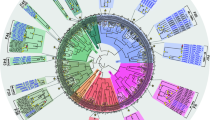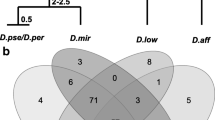Abstract
Transposable elements (TEs) are ubiquitous components of nearly all genomes studied. These elements are highly variable in copy number, molecular structure and transposition strategies. They can move within and between genomes, thus increasing their copy numbers and avoiding being eliminated by stochastic and deterministic processes. hobo is a class II element isolated from Drosophila melanogaster. Previous phylogenetic analyses have shown that the canonical hobo element from D. melanogaster has a sister group formed by sequences found in D. willistoni (called howilli2) and D. mojavensis (called homo1). In the present study, we investigated 36 Drosophilidae species for sequences similar to howilli2 and homo1 using degenerate primers. Additionally, in silico searches were performed in 21 available Drosophila genomes. The obtained sequences formed a monophyletic sister group with the canonical hobo element; we termed these sequences ‘hobo-brothers’ elements. These elements showed a patch distribution and incongruities with the TE and host species phylogenies, suggesting possible cases of horizontal transfer (HT). Species that possess hobo-brothers sequences are from the New World, mainly Neotropical areas. In addition, the estimated divergence of the sequences found showed that these elements are or were recently active; the large number of HT events observed suggests that these elements could be experiencing an expansion process in Neotropical genomes. A comparison of these results with the literature is discussed with regard to the importance of the time and location of horizontal transposon transfer events.




Similar content being viewed by others
References
Andersson JO (2005) Lateral gene transfer in eukaryotes. Cell Mol Life Sci 62:1182–1197
Arensburger P, Hice RH, Zhou L, Smith RC, Tom AC, Wright JA, Knapp J, Brochta DAO, Craig NL, Atkinson PW (2011) Phylogenetic and functional characterization of the hAT transposon superfamily. Genetics 111:1–34
Bartolomé C, Bello X, Maside X (2009) Widespread evidence for horizontal transfer of transposable elements across Drosophila genomes. Genome Biol 10:R22
Blackman RK, Gelbart WM (1989) The transposable element hobo of Drosophila melanogaster. In: Mobile DNA, Berg DE, Howe M. Am Soc Microbiol, Washington DC, pp. 523–529
Boussy IA, Itoh M (2004) Wanderings of hobo: a transposon in Drosophila melanogaster and its close relatives. Genetica 120:125–136
Carareto C (2011) Tropical Africa as a cradle for horizontal transfers of transposable elements between species of the genera Drosophila and Zaprionus. Mob Genet Elem 1:179–186
Daniels SB, Chovnick A, Boussy IA (1990a) Distribution of hobo transposable elements in the genus Drosophila. Mol Biol Evol 7:589–606
Daniels SB, Petterson KR, Strausbaugh LD, Kidwell MG, Chovnick AC (1990b) Evidence for horizontal transmission of the P transposable elements between Drosophila species. Genetics 124:339–355
Deprá M, Panzera Y, Ludwig A, Valente VLS, Loreto ELS (2010) hosimary: a new hAT transposon group involved in horizontal transfer. Mol Genet Genomics 283:451–459
Eickbush TH, Eickbush DG (2007) Finely orchestrated movements: evolution of the ribosomal RNA genes. Genetics 175:477–485
Feschotte C, Pritham EJ (2007) DNA transposons and the evolution of eukaryotic genomes. Annu Rev Genet 41:331–368
Graur D, LI WH (2000) Fundamentals of molecular evolution, 2nd edn. Sinauer Associates, Sunderland, MA
Hua-Van A, Le Rouzic A, Boutin TS, File EJ, Capy P (2011) The struggle for life of the genome’s selfish architects. Biol Direct 6:19
Kidwell MG (1993) Lateral transfer in natural populations of eukaryotes. Annu Rev Genet 27:235–256
Ladevèze V, Chaminade N, Lemeunier F, Periquet P, Aulard S (2012) General survey of hAT transposon superfamily with highlight on hobo element in Drosophila. Genetica 140:375–392
Lohe AR, Moriyama EM, Lidholm DA, Hartl DL (1995) Horizontal transmission, vertical inactivation, and stochastic loss of mariner like transposable elements. Mol Biol Evol 12:62–72
Loreto ELS, Carareto C, Capy P (2008) Revisiting horizontal transfer of transposable elements in Drosophila. Heredity 100:545–554
McGinnis W, Shermoen AW, Beckendorf SK (1983) A transposable element insert just 5′ to Drosophila glue protein gene alters gene expression and chromatin structure. Cell 34:75–84
Mota NR, Robe LJ, Valente VLS, Budnik M, Loreto ELS (2008) Phylogeny of the Drosophila mesophragmatica group (Diptera, Drosophilidae): an example of Andean evolution. Zool Sci 25:526–532
Mota NR, Ludwig A, Valente VL, Loreto ELS (2010) Harrow: new Drosophila hAT transposons involved in horizontal transfer. Insect Mol Biol 19:217–228
Oliveira LFV, Wallau GL, Loreto ELS (2009) Isolation of high quality DNA: a protocol combining “rennet” and glass milk. Electron J Biotechnol 12:1–6
Ortiz MF, Loreto ELS (2008) The hobo-related elements in the melanogaster species group. Genet Res 90:243–252
Ortiz MF, Loreto ELS (2009) Characterization of new hAT transposable elements in 12 Drosophila genomes. Genetica 135:67–75
Periquet G, Lemeunier F, Bigot Y, Hamelin MH, Bazin C, Ladevèze V, Eeken J, Galindo MI, Pascual L, Boussy I (1994) The evolutionary genetics of the hobo transposable element in the Drosophila. Genetica 93:79–90
Posada C, Crandall KA (1998) MODELTEST: testing the model of DNA substitution. Bioinformatics 14:817–818
Robe LJ, Loreto ELS, Valente VLS (2010) Radiation of the Drosophila subgenus (Drosophilidae, Diptera) in the Neotropics. J Zool Syst Evolut Res 4:310–321
Ronquist F, Huelsenbeck JP (2003) MRBAYES3: bayesian phylogenetic inferenceunder mixed models. Bioinformatics 19:1572–1574
Schaack S, Gilbert C, Feschotte C (2010) Promiscuous DNA: horizontal transfer of transposable elements and why it matters for eukaryotic evolution. Trends Ecol Evol 25:537–546
Silva JC, Kidwell MG (2000) Horizontal transfer and selection in the evolution of P elements. Mol Biol Evol 17:1542–1557
Silva JC, Loreto ELS, Clark JB (2004) Factors that affect the horizontal transfer of transposable elements. Curr Issues Mol Biol 6:57–71
Simmons G (1992) Horizontal transfer of hobo transposable elements within the Drosophila melanogaster species complex: evidence from DNA sequencing. Mol Biol Evol 9:1050–1060
Staden R (1996) The Staden sequence analysis package. Mol Biotechnol 5:233–241
Streck RD, MacGaffey JE, Beckendorf SK (1986) The structure of hobo transposable elements and their insertion sites. EMBO 5:3615–3623
Tamura K, Subramanian S, Kumar S (2004) Temporal patterns of fruit fly (Drosophila) evolution revealed by mutation clocks. Mol Biol Evol 21:36–44
Tamura K, Peterson D, Peterson N, Stecher G, Nei M, Kumar S (2011) MEGA5: molecular evolutioary genetics analysis using maximum likelihood, evolutionary distance, and maximum parsimony methods. Mol Biol Evol 4:1–6
Thompson JD, Higgins DG, Gibson TJ (1994) CLUSTAL W: improving the sensitivity of progressive multiple sequence alignment through sequence weighting, position-specific gap penalties and weight matrix choice. Nucleic Acids Res 22:4673–4680
Throckmorton LH (1975) The phylogeny, ecology and geography of Drosophila. In: King RC (ed) Handbook of genetics. Plenun, NewYork, pp 421–469
Torti C, Gomulski LM, Bonizzoni M, Murelli V, Moralli D, Guglielmino CR, Raimondi E, Crisafulli D, Capy P, Gasperi G, Malacrida AR (2005) Cchobo, a hobo-related sequence in Ceratitis capitata. Genetica 123:313–325
Wallau GL, Ortiz MF, Loreto ELS (2012) Horizontal transposon transfer in eukarya: detection, bias, and perspectives. Genome Biol Evol 4:689–699
Werren JH (2011) Selfish genetic elements, genetic conflict, and evolutionary innovation. PNAS 108:10863–10870
Wicker T, Sabot F, Hua-Van A, Bennetzen JL, Capy P, Chalhoub B, Flavel A, Leroy P, Morgante M, Panaud O, Paux E, Sanmiguel P, Schulman AH (2007) A unified classification system for eukaryotic transposable elements. Nat Rev Genet 8:973–982
Acknowledgments
We thank Dr. Lizandra Robe and Gabriel Wallau for suggestions. This study was supported by research grants and fellowships from CAPES (Coordenação de Aperfeiçoamento de Pessoal de Nível Superio), CNPq-Conselho Nacional de Desenvolvimento Científico e Tecnológico, PRONEX-FAPERGS (10/0028-7) and Fapergs (11/0938-0).
Author information
Authors and Affiliations
Corresponding author
Electronic supplementary material
Below is the link to the electronic supplementary material.
Rights and permissions
About this article
Cite this article
Bernardo, L.P., Loreto, E.L.S. hobo-brothers elements and their time and place for horizontal transfer. Genetica 141, 471–478 (2013). https://doi.org/10.1007/s10709-013-9746-1
Received:
Accepted:
Published:
Issue Date:
DOI: https://doi.org/10.1007/s10709-013-9746-1




